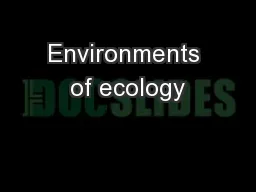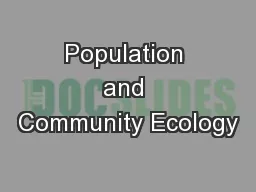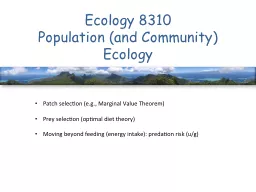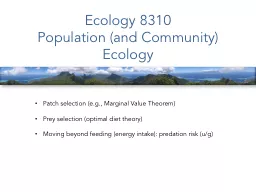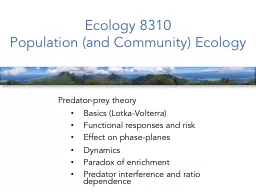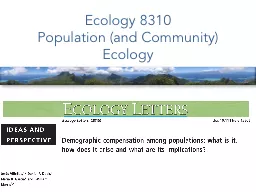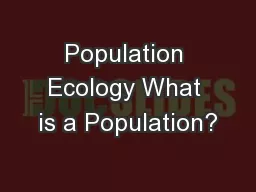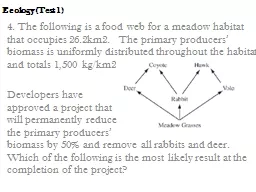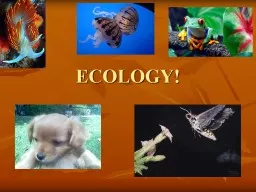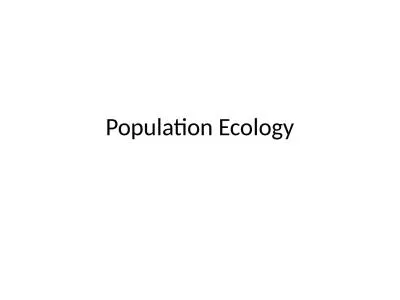PPT-Ecology 8310 Population (and Community) Ecology
Author : natalia-silvester | Published Date : 2019-06-21
HW 1 Agestructured populations Stagestructure populations Life cycle diagrams Projection matrices Context Sea Turtle Conservation But first background Population
Presentation Embed Code
Download Presentation
Download Presentation The PPT/PDF document "Ecology 8310 Population (and Community) ..." is the property of its rightful owner. Permission is granted to download and print the materials on this website for personal, non-commercial use only, and to display it on your personal computer provided you do not modify the materials and that you retain all copyright notices contained in the materials. By downloading content from our website, you accept the terms of this agreement.
Ecology 8310 Population (and Community) Ecology: Transcript
HW 1 Agestructured populations Stagestructure populations Life cycle diagrams Projection matrices Context Sea Turtle Conservation But first background Population Structure . Image from Wikimedia Commons. Global human population. United Nations . projections (2004) . (. red. , . orange. , . green. ). . U. S. Census Bureau modern (. blue. ) . & historical . (. black. ) . holism. reductionism. climax community. Organicism. teleology. deep ecology. Gaia theory . positive versus negative biotic interactions. pristine myth. Films often portray organisms and ecological interactions . Population Characteristics. Density. - # of individuals per unit of . area. Determined by…. counts . sample size estimate . indirect indicators . mark-recapture. Dispersion. In short, . ecology . is the scientific study of the . interactions of organisms with their environment. .. All organisms . interact. with other organisms in their surroundings and with the nonliving portion of their environment. . Patch selection (e.g., Marginal Value Theorem). Prey selection (optimal diet theory). Moving beyond feeding (energy intake): predation risk. . (u/g). Patch selection. :. Consider a forager moving among many patches during a foraging bout (rodent among seed caches, pollinator among flowers, etc.). Patch selection (e.g., Marginal Value Theorem). Prey selection (optimal diet theory). Moving beyond feeding (energy intake): predation risk. . (u/g). Patch selection. :. Consider a forager moving among many patches during a foraging bout (rodent among seed caches, pollinator among flowers, etc.). Predator-prey theory. Basics (. Lotka-Volterra. ). Functional responses and risk. Effect on phase-planes. Dynamics. Paradox of enrichment. Predator interference and ratio dependence. How do predators respond to prey?. Context. Context. What accounts for the distributional limit?. d. ispersal (perhaps with . Allee. effects). b. iotic and abiotic factors. If environmental factors, then:. λ. (N≈0) > 1 within distribution. An interbreeding group of the . same species. living in the same general area. may be distinguished by natural or . . arbitrary boundaries. Population Density vs Dispersion. the number of individuals per unit area or volume. Developers have . approved a project that . will permanently reduce . the primary producers’ . biomass by 50% and remove all rabbits and deer. Which of the following is the most likely result at the completion of the project?. Seguing into from populations to communities. Species interactions. Lotka-Volterra. equations. Competition. Adding in resources. Species interactions:. Competition (- , -). Predation (+ , -). (. Herbivory. I. Biotic and . Abiotic. Factors. A. Biotic Factors-- all living things that inhabit an environment. 1. relationships with organisms of the same or different species. . B. . Abiotic. Factors: The nonliving environment. SW: discuss with their groups how estimating a population could be used in a real world situation.. Population Ecology. Measuring a population. Growth Curves. Biotic Potential vs. Environmental. Resistance. What is a population and how do ecologists study it. Explain . the difference between a niche and . habitat. Explain the predator/prey . relationship and carrying . capacity on the graph. . Explain why animals fight.
Download Document
Here is the link to download the presentation.
"Ecology 8310 Population (and Community) Ecology"The content belongs to its owner. You may download and print it for personal use, without modification, and keep all copyright notices. By downloading, you agree to these terms.
Related Documents


